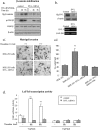Protease-activated receptor-1 (PAR1) acts via a novel Galpha13-dishevelled axis to stabilize beta-catenin levels
- PMID: 20223821
- PMCID: PMC2865281
- DOI: 10.1074/jbc.M109.072843
Protease-activated receptor-1 (PAR1) acts via a novel Galpha13-dishevelled axis to stabilize beta-catenin levels
Abstract
We have previously shown a novel link between hPar-1 (human protease-activated receptor-1) and beta-catenin stabilization. Although it is well recognized that Wnt signaling leads to beta-catenin accumulation, the role of PAR1 in the process is unknown. We provide here evidence that PAR1 induces beta-catenin stabilization independent of Wnt, Fz (Frizzled), and the co-receptor LRP5/6 (low density lipoprotein-related protein 5/6) and identify selective mediators of the PAR1-beta-catenin axis. Immunohistological analyses of hPar1-transgenic (TG) mouse mammary tissues show the expression of both Galpha(12) and Galpha(13) compared with age-matched control counterparts. However, only Galpha(13) was found to be actively involved in PAR1-induced beta-catenin stabilization. Indeed, a dominant negative form of Galpha(13) inhibited both PAR1-induced Matrigel invasion and Lef/Tcf (lymphoid enhancer factor/T cell factor) transcription activity. PAR1-Galpha(13) association is followed by the recruitment of DVL (Dishevelled), an upstream Wnt signaling protein via the DIX domain. Small interfering RNA-Dvl silencing leads to a reduction in PAR1-induced Matrigel invasion, inhibition of Lef/Tcf transcription activity, and decreased beta-catenin accumulation. It is of note that PAR1 also promotes the binding of beta-arrestin-2 to DVL, suggesting a role for beta-arrestin-2 in PAR1-induced DVL phosphorylation dynamics. Although infection of small interfering RNA-LRP5/6 or the use of the Wnt antagonists, SFRP2 (soluble Frizzled-related protein 2) or SFRP5 potently reduced Wnt3A-mediated beta-catenin accumulation, no effect was observed on PAR1-induced beta-catenin stabilization. Collectively, our data show that PAR1 mediates beta-catenin stabilization independent of Wnt. We propose here a novel cascade of PAR1-induced Galpha(13)-DVL axis in cancer and beta-catenin stabilization.
Figures









Similar articles
-
Activated protein C promotes protease-activated receptor-1 cytoprotective signaling through β-arrestin and dishevelled-2 scaffolds.Proc Natl Acad Sci U S A. 2011 Dec 13;108(50):E1372-80. doi: 10.1073/pnas.1112482108. Epub 2011 Nov 21. Proc Natl Acad Sci U S A. 2011. PMID: 22106258 Free PMC article.
-
Mammary gland tissue targeted overexpression of human protease-activated receptor 1 reveals a novel link to beta-catenin stabilization.Cancer Res. 2006 May 15;66(10):5224-33. doi: 10.1158/0008-5472.CAN-05-4234. Cancer Res. 2006. PMID: 16707447
-
Sequential activation and inactivation of Dishevelled in the Wnt/beta-catenin pathway by casein kinases.J Biol Chem. 2011 Mar 25;286(12):10396-410. doi: 10.1074/jbc.M110.169870. Epub 2011 Feb 1. J Biol Chem. 2011. PMID: 21285348 Free PMC article.
-
New steps in the Wnt/beta-catenin signal transduction pathway.Recent Prog Horm Res. 2000;55:225-36. Recent Prog Horm Res. 2000. PMID: 11036939 Review.
-
PAR1 plays a role in epithelial malignancies: transcriptional regulation and novel signaling pathway.IUBMB Life. 2011 Jun;63(6):397-402. doi: 10.1002/iub.452. Epub 2011 May 9. IUBMB Life. 2011. PMID: 21557443 Review.
Cited by
-
Evidence of a common mechanism of disassembly of adherens junctions through Gα13 targeting of VE-cadherin.J Exp Med. 2014 Mar 10;211(3):579-91. doi: 10.1084/jem.20131190. Epub 2014 Mar 3. J Exp Med. 2014. PMID: 24590762 Free PMC article.
-
Determinant role for the gep oncogenes, Gα12/13, in ovarian cancer cell proliferation and xenograft tumor growth.Genes Cancer. 2015 Jul;6(7-8):356-364. doi: 10.18632/genesandcancer.72. Genes Cancer. 2015. PMID: 26413218 Free PMC article.
-
Regulation of protease-activated receptor signaling by post-translational modifications.IUBMB Life. 2011 Jun;63(6):403-11. doi: 10.1002/iub.442. Epub 2011 Mar 24. IUBMB Life. 2011. PMID: 21438117 Free PMC article. Review.
-
A novel role for factor VIII and thrombin/PAR1 in regulating hematopoiesis and its interplay with the bone structure.Blood. 2013 Oct 10;122(15):2562-71. doi: 10.1182/blood-2012-08-447458. Epub 2013 Aug 27. Blood. 2013. PMID: 23982175 Free PMC article.
-
Low-density lipoprotein receptor-related protein 6 is a novel coreceptor of protease-activated receptor-2 in the dynamics of cancer-associated β-catenin stabilization.Oncotarget. 2017 Jun 13;8(24):38650-38667. doi: 10.18632/oncotarget.16246. Oncotarget. 2017. PMID: 28418856 Free PMC article.
References
-
- Nierodzik M. L., Karpatkin S. (2006) Cancer Cell 10, 355–362 - PubMed
-
- Even-Ram S., Uziely B., Cohen P., Grisaru-Granovsky S., Maoz M., Ginzburg Y., Reich R., Vlodavsky I., Bar-Shavit R. (1998) Nat. Med. 4, 909–914 - PubMed
-
- Yin Y. J., Katz V., Salah Z., Maoz M., Cohen I., Uziely B., Turm H., Grisaru-Granovsky S., Suzuki H., Bar-Shavit R. (2006) Cancer Res. 66, 5224–5233 - PubMed
-
- Déry O., Corvera C. U., Steinhoff M., Bunnett N. W. (1998) Am. J. Physiol. 274, C1429–C1452 - PubMed
Publication types
MeSH terms
Substances
LinkOut - more resources
Full Text Sources
Molecular Biology Databases
Miscellaneous

